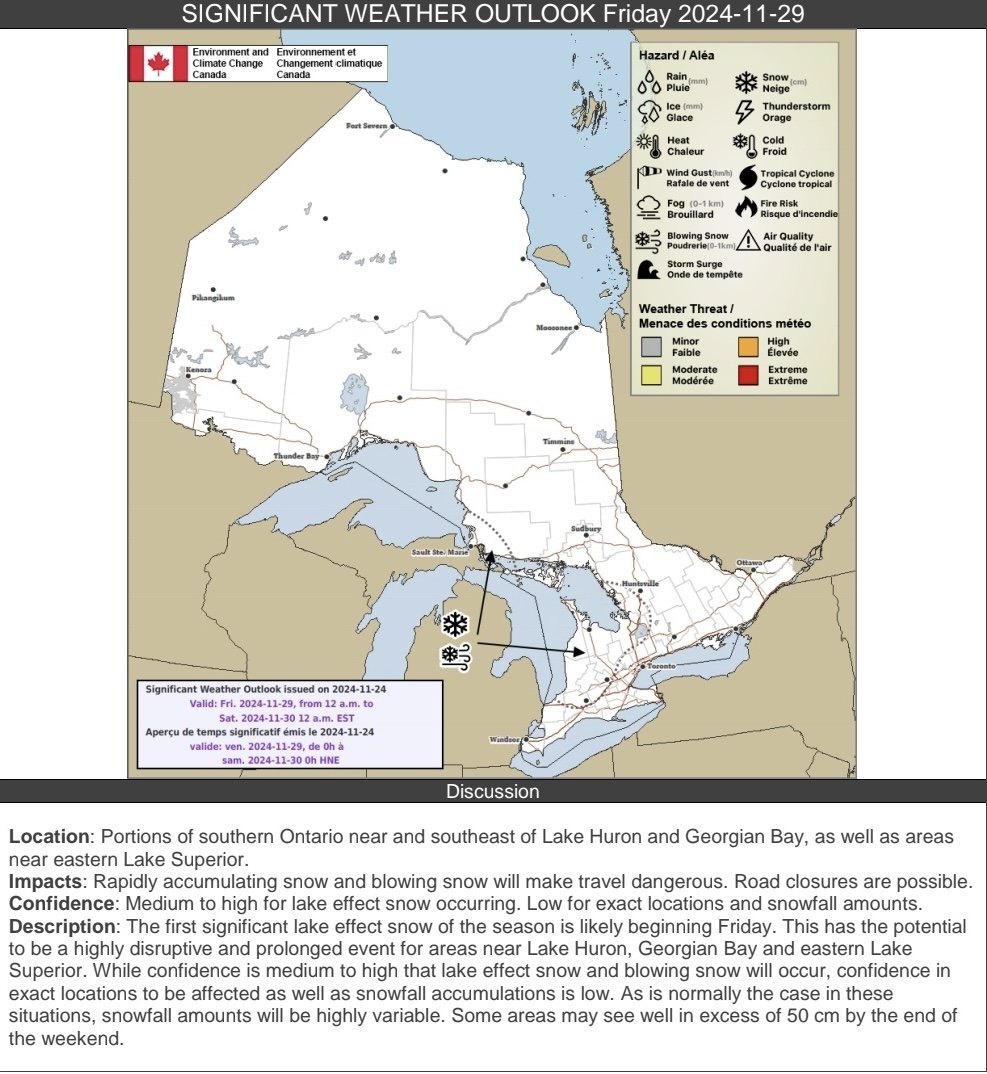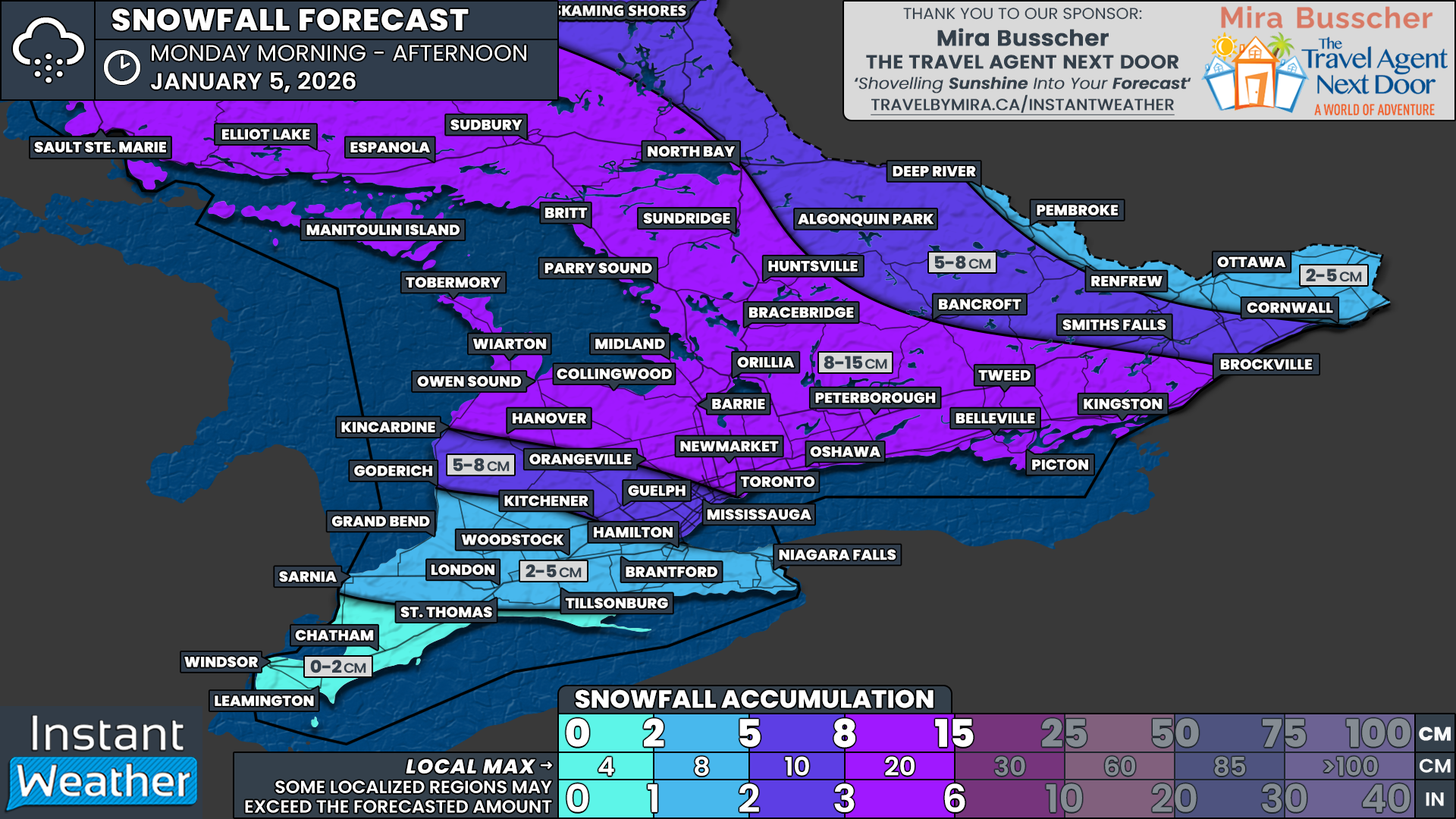Intense Snow Squalls Could Bring Up to 50-100cm of Snow to Parts of Ontario This Weekend
/As we approach the first day of meteorological winter this Sunday, Ontario is preparing for a substantial blast of snow squalls that will make the season's arrival unmistakable. Beginning Thursday in Northern Ontario and Friday in Southern Ontario, persistent squalls are set to bury parts of the traditional snowbelt regions under as much as 50-100 cm of snow by the end of the weekend.
The first extended period of cold air has settled over Ontario, combining with the warm waters of the Great Lakes to create ideal conditions for lake effect snow. Parry Sound and Muskoka got a preview of what’s to come, waking up to a winter wonderland on Wednesday morning. While the lake effect snow machine has temporarily quieted as winds shift, it’s poised to roar back to life over the next several days.
Snow squall activity will restart as early as Thursday morning in Northern Ontario, with an intense band developing off Lake Superior. This narrow and powerful squall is expected to affect the corridor between Wawa and Sault Ste. Marie through Thursday and into Friday. Snowfall rates could reach up to 5 cm per hour, and if the band lingers over one area for an extended time, accumulation will add up quickly.
On Thursday, a system moving up the Northeastern U.S. will brush Southern Ontario. Most of the precipitation is expected to remain on the U.S. side of the border, but some areas in Ontario, including parts of the Greater Toronto Area (GTA) and Niagara region, could see light mixed precipitation or even their first flurries of the season. Little to no accumulation is expected, but slushy road conditions may develop for the Thursday morning commute.
As the system exits, winds will shift to a westerly or northwesterly direction late Thursday, triggering the return of lake-effect snow squalls. These squalls will intensify overnight and into Friday morning.
PRECIPITATION TYPE - MAP FROM WEATHERBELL
Current models suggest the primary snow squall band will stretch across the Bruce Peninsula, move over Georgian Bay, and come ashore between Parry Sound and MacTier. Further inland, areas along the Hwy 11 corridor, including Huntsville and Gravenhurst, will also be affected.
Additional squalls are expected off Lake Huron, impacting regions such as Kincardine, Owen Sound, Hanover, Wingham, and Mount Forest.
One of the biggest concerns is the potential for squalls to remain stationary over specific areas for extended periods. Models suggest some regions could face 24-48 hours of relentless snowfall, with rates reaching 3-5 cm per hour from Friday morning to early Sunday.
Road conditions are expected to deteriorate rapidly, and travel in affected areas should be avoided starting late Thursday. Near-zero visibility, combined with rapid snow accumulation and blowing snow, may create blizzard-like conditions. Improvements are unlikely until late in the weekend or even early next week.
By Sunday morning, a slight change in wind direction could push the Georgian Bay snow squalls southward into Simcoe County and the Kawartha Lakes region. Similarly, Lake Huron squalls may shift to target areas like Goderich, Stratford, and Listowel.
Lake Erie and Lake Ontario could also generate brief lake effect activity on Sunday, potentially impacting the Southern Niagara region, Prince Edward County, and Kingston.
Environment Canada is also mentioning the potential for multiple rounds of lake-effect snow and squalls. They have highlighted areas east of Lake Huron and Georgian Bay in a ‘high’ weather threat for Friday and Saturday with locally up to 20-30cm of snow on both days.
There is also a ‘moderate’ weather threat on Sunday southeast of Lake Huron and Georgian Bay with locally up to 10-20cm. Combined, Environment Canada’s forecast is suggesting that snowfall totals could range from 50 to 80cm over those 3 days!
Snow squalls are highly localized, often only a few dozen kilometres wide, meaning snowfall totals can vary dramatically over short distances. One area might receive 50+ cm, while another just down the road may see barely a dusting.
Because of this variability, we are focusing on general zones for now. Higher-resolution models will help refine the forecast as we approach the weekend, and updates will be provided accordingly.
Snowfall totals across the traditional snowbelt regions could be significant:
50-100 cm: Areas east of Georgian Bay and Lake Huron, including Bracebridge, Gravenhurst, Huntsville, Parry Sound, Owen Sound, Kincardine, Goderich, and Hanover.
25-50 cm: Surrounding regions, including the Bruce Peninsula, Collingwood, Midland, and Orillia. Totals will drop quickly further from the snowbelt.
5-15 cm: Localized areas in the Southern Niagara region (e.g., Port Colborne and Fort Erie) and Kingston, mainly on Sunday, if lake effect activity drifts north of the border.
For Northern Ontario, the corridor between Wawa and Sault Ste. Marie is expected to see snowfall totals between 50-100 cm from Thursday morning through late Sunday. Accumulations will taper off sharply as you move away from the Lake Superior shoreline.
Stay tuned for further updates in the coming days as we break down this dynamic weather event and provide more detailed forecast maps.



























































